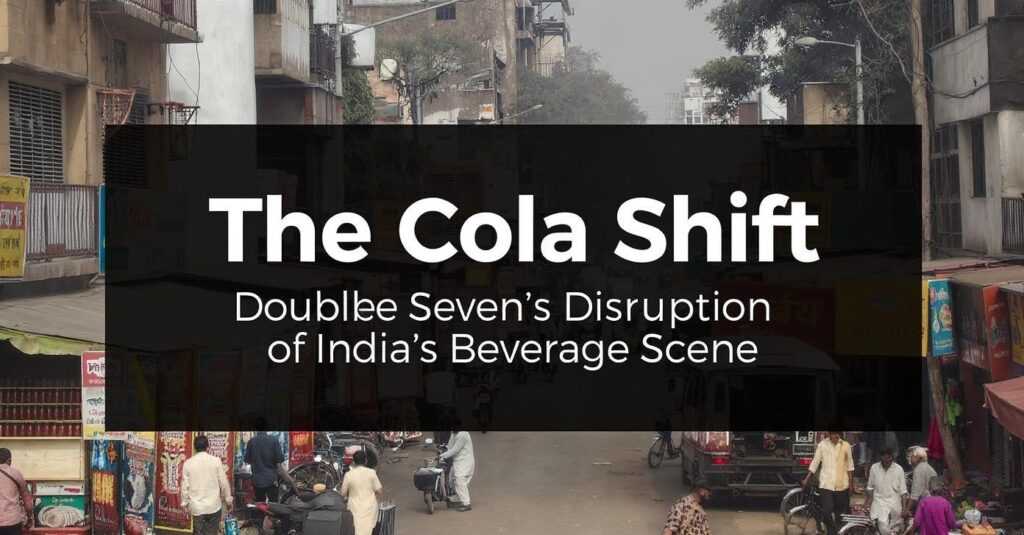India’s Cola Revolution: How Double Seven Replaced Coca-Cola is one of the most remarkable stories in the nation’s business and cultural history. In the late 1970s, the exit of Coca-Cola from India marked a turning point in the country’s beverage industry. What followed was not merely a substitution but a national movement that would redefine consumer preferences and industrial strategy.
Double Seven, a homegrown cola brand, rose from the vacuum left by Coca-Cola. It wasn’t just a product—it was a symbol of self-reliance, economic independence, and the assertion of Indian identity in the consumer marketplace. India’s Cola Revolution: How Double Seven Replaced Coca-Cola tells the story of this transformation and its ripple effects across businesses, policies, and the population.
The Political Backdrop: Why Coca-Cola Left India
To understand India’s Cola Revolution: How Double Seven Replaced Coca-Cola, one must begin with the events of 1977. The Janata Party, newly in power, introduced strict regulations under the Foreign Exchange Regulation Act (FERA). This policy required multinational companies operating in India to dilute their equity holdings and disclose proprietary information to local partners.
Coca-Cola, known globally for its fiercely protected secret formula, refused to comply with these demands. As a result, the company exited the Indian market. Its departure left a gaping hole in a growing consumer economy, where cola had become a popular refreshment choice.
The Indian government, sensing both a political and market opportunity, introduced an indigenous alternative—Double Seven Cola.
The Birth of Double Seven: A Swadeshi Answer
Double Seven was not just a new brand. It was the government’s strategic response to the Coca-Cola exit and a direct implementation of the swadeshi (self-reliant) philosophy. The name \”Double Seven\” referred to the pivotal year 1977, which symbolized political change and economic assertion.
Produced by Modern Food Industries, a public sector enterprise, Double Seven was intended to be more than a beverage. It represented national pride, industrial strength, and consumer independence. India’s Cola Revolution: How Double Seven Replaced Coca-Cola began with this deeply symbolic and strategic move.
Branding with National Sentiment
Unlike Coca-Cola’s flashy advertising and Western branding, Double Seven’s positioning was grounded in simplicity, affordability, and emotional appeal. Marketing campaigns centered around swadeshi values, using slogans and visuals that emphasized patriotism and economic nationalism.
Double Seven was sold in government offices, public sector institutions, schools, and railway stations. This widespread availability gave it an edge over competitors, helping embed it deeply into Indian society.
India’s Cola Revolution: How Double Seven Replaced Coca-Cola found its fuel in nationalistic messaging. The Indian consumer saw the brand not just as a drink but as a contribution to national development.
Supporting Indian Industry Through B2B Ecosystems
One of the most overlooked aspects of India’s Cola Revolution: How Double Seven Replaced Coca-Cola is the impact it had on B2B enterprises. The exit of Coca-Cola disrupted multiple supply chains, from bottling to marketing to logistics.
Double Seven gave Indian businesses a new opportunity. From local bottlers to transporters, advertising agencies to refrigeration equipment providers, a wide network of Indian businesses became part of this new cola economy. The production, distribution, and marketing of Double Seven were managed entirely within the country.
This approach not only stimulated domestic commerce but also helped build resilience in India’s FMCG supply chain—a crucial lesson for businesses today.
Cultural Acceptance and Widespread Reach
The cultural acceptance of Double Seven was rapid and profound. It soon became a fixture at family gatherings, community events, college festivals, and street-side shops. The flavor was distinct—less sweet than Coca-Cola, slightly spicier, and tailored to Indian taste buds.
India’s Cola Revolution: How Double Seven Replaced Coca-Cola succeeded in part because of this taste adaptation. It wasn’t trying to mimic Coca-Cola but rather offering something authentically Indian.
This product differentiation helped win over a large portion of the rural and semi-urban market. The beverage was affordable, familiar, and aligned with the broader cultural and economic mood of the time.
Rise of Other Homegrown Alternatives
Double Seven’s success also opened the doors for other Indian soft drink brands. Thums Up, Campa Cola, Gold Spot, and Limca gained popularity during the same period. Each of these brands brought its own unique flavor and marketing twist, adding to the diversity and competitiveness of the Indian soft drink market.
Yet, India’s Cola Revolution: How Double Seven Replaced Coca-Cola remained unique because of its origin—it was not just a business venture but a government-backed movement. While Thums Up eventually became dominant and was later acquired by Coca-Cola, Double Seven stood as the original symbol of economic defiance and swadeshi spirit.
State Support and Political Promotion
Another defining characteristic of India’s Cola Revolution: How Double Seven Replaced Coca-Cola was the extent of state support the brand received. Political leaders endorsed the drink in public events. Government contracts and institutional sales provided a steady stream of revenue and visibility.
This direct promotion by state machinery gave Double Seven an unparalleled platform to scale. Indian companies that partnered with Double Seven found themselves supported by both policy and public sentiment.
In a business environment where brand visibility often determines success, such government backing played a critical role in establishing Double Seven as a dominant player.
Why It Ultimately Faded
Despite its strong start, Double Seven eventually lost its sheen. The liberalization of the Indian economy in the 1990s brought back multinational brands, including Coca-Cola. With deeper pockets, superior marketing, and stronger brand recall, Coca-Cola reclaimed its position in the Indian market.
Double Seven, being part of a bureaucratic public sector enterprise, struggled to adapt to the rapidly changing dynamics of post-liberalization India. While India’s Cola Revolution: How Double Seven Replaced Coca-Cola had changed the narrative, it couldn’t sustain its dominance in the new competitive environment.
Still, its legacy remains as a reminder of what indigenous innovation and public support can achieve.
Lessons for Modern Indian Businesses
The lessons from India’s Cola Revolution: How Double Seven Replaced Coca-Cola are just as relevant today as they were in the 1970s and 80s. In a world increasingly driven by localization, sustainability, and economic nationalism, Indian companies can revisit this revolution for insights.
Local Alignment Wins: Brands that understand local culture, preferences, and values can outcompete even global giants.
Policy Synergy Matters: Strategic alignment with government policies can open significant opportunities for growth.
Affordable Innovation: Creating quality products at affordable prices can help penetrate underserved markets.
Build B2B Ecosystems: Supporting local vendors, suppliers, and partners builds resilience and scalability.
India’s Cola Revolution: How Double Seven Replaced Coca-Cola is not just a history lesson. It’s a business model, a marketing case study, and a cultural narrative rolled into one.
Looking Ahead: The Return of Swadeshi Thinking
Today, with the Indian government’s push for Make in India, Atmanirbhar Bharat, and Vocal for Local, the themes that powered Double Seven are reemerging in new forms. Startups, legacy businesses, and policymakers are once again focusing on building indigenous strength across sectors.
India’s Cola Revolution: How Double Seven Replaced Coca-Cola is being re-evaluated in this context—as a successful example of how public support, national branding, and economic opportunity can converge to deliver transformative outcomes.
Read Full Article : https://bizinfopro.com/news/marketing-news/indias-cola-revolution-how-double-seven-replaced-coca-cola/
About Us : BizInfoPro is a modern business publication designed to inform, inspire, and empower decision-makers, entrepreneurs, and forward-thinking professionals. With a focus on practical insights and in‑depth analysis, it explores the evolving landscape of global business—covering emerging markets, industry innovations, strategic growth opportunities, and actionable content that supports smarter decision‑making.



